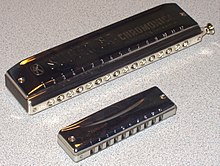Harmonica/Why should I Play Harmonica?
The Harmonica is a very versatile wood-wind instrument that use free-reeds to produce sounds. In modern times, it is very likely that your first harmonica is not out of your own money, but rather, a gift given to you by someone who enjoyed harmonica (or, perhaps, just trying to give a cheap gift). So you may wonder: "Why should I even bother learning harmonica, since I prefer guitar/violin/keyboard/drums/saxophone/etc.?" You may even think of it as a mere toy!

Well, the harmonica, is much more than a mere toy; it can produce rich music that is impossible for many other instruments. It is easy to learn; no need to remember any fingerings etc., just remember that the notes ascend in certain way. Furthermore, it can play numerous intervals (two or more notes), which is difficult or impossible for many other wind instruments. It also works very well in the modern musical setting, where one needs to play most music through an amplifier or loudspeaker. A harmonica player can easily adapt to this by cupping a microphone and his harmonica in his hands, without sacrificing any other aspect of playing.
It is also very fundamental to the music of Blues - in order to acquire that soulful sound, unique in soul music and Blues, a harmonica is needed. Thus, most people expect a Blues band to have a harmonica player. However, the harmonica doesn't just stop at the Blues, it also crosses many musical boundaries - the diatonic harmonica is frequently used for rock, country, folk music and Irish jigs and reels and the chromatic harmonica is often associated with Jazz music, and more recently, Classical music. The tremolo harmonica is often used for Japanese folk songs.
Learning the harmonica can improve your breathing, and thus, your health. By forcing you to breath out and in to play melody, the diaphragm muscle will get exercised a lot. This is why, especially in North America, a harmonica is sometimes given to people with breathing difficulties.
The harmonica is also a very portable instrument. The Hohner 270, a 3-octave chromatic harmonica, together with the case, can fit into the inner pocket of an unmodified jacket. Such is the case with the Hohner Super 64 in a tiny daypack. No other acoustic instruments with similar range can accomplish that feat.
| Harmonica |
|---|
| Getting started: Why should I Play Harmonica? | Types of harmonica | Anatomy of a Harmonica | Harmonica Purchasing guide |
| Playing the harmonica: Basic Holding and Playing a Harmonica | Tablature | Basic Chords | Bending |
| Additional techniques: Advance Chords | Advance techniques | Self accompaniment |
| General harmonica theory: Chromatic Harmonica | Positions | Tremelo | Ensemble Playing | Music Style | Learning Songs | Improvising | Recording | Playing with Amp |
| Cleaning and maintainence: Basic Maintainence and Care | Advance Maintainence |Harmonica Modifications |Tuning |
| Appendices: Harmonica Layouts and Alternate Tunings| Harmonica Positions Chart | Blues | Writing Songs |